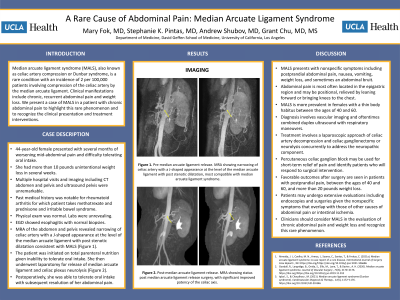Monday Poster Session
Category: Stomach
P2824 - A Rare Cause of Abdominal Pain: Median Arcuate Ligament Syndrome
Monday, October 23, 2023
10:30 AM - 4:15 PM PT
Location: Exhibit Hall

Has Audio
.jpg)
Mary Fok, MD
University of California, Los Angeles
Los Angeles, California
Presenting Author(s)
Mary Fok, MD, Stephanie K. Pintas, MD, Andrew Shubov, MD, Grant Chu, MD, MS
University of California, Los Angeles, Los Angeles, CA
Introduction: Median arcuate ligament syndrome (MALS), also known as celiac artery compression or Dunbar syndrome, is a rare condition with an incidence of 2 per 100,000 patients involving compression of the celiac artery by the median arcuate ligament. Clinical manifestations include chronic, recurrent abdominal pain and weight loss. We present a case of MALS in a patient with chronic abdominal pain to highlight this rare phenomenon and to recognize the clinical presentation and treatment interventions.
Case Description/Methods: A 44 year old female presented with several months of worsening mid-abdominal pain and difficulty tolerating oral intake. She had more than 10 pounds unintentional weight loss in several weeks. Multiple hospital visits and imaging including CT abdomen and pelvis and ultrasound pelvis were unremarkable. Past medical history was notable for rheumatoid arthritis for which patient takes methotrexate and prednisone and irritable bowel syndrome. Physical exam was normal. Labs were unrevealing. EGD showed esophagitis with normal biopsies. MRA of the abdomen and pelvis revealed narrowing of celiac artery with a J-shaped appearance at the level of the median arcuate ligament with post stenotic dilatation consistent with MALS (Figure 1). The patient was initiated on total parenteral nutrition given inability to tolerate oral intake. She then underwent laparotomy for release of median arcuate ligament and celiac plexus neurolysis. Postoperatively, she was able to tolerate oral intake with subsequent resolution of her abdominal pain.
Discussion: MALS presents with nonspecific symptoms including postprandial abdominal pain, nausea, vomiting, and weight loss. MALS is more prevalent in females with a thin body habitus between the ages of 40 and 60. Diagnosis involves vascular imaging and oftentimes combined duplex ultrasound with respiratory maneuvers. Treatment involves a laparoscopic approach of celiac artery decompression and celiac ganglionectomy or neurolysis concurrently to address the neuropathic component. Favorable outcomes after surgery are seen in patients with postprandial pain, between the ages of 40 and 60, and more than 20 pounds weight loss. Patients may undergo extensive evaluations including endoscopies and surgeries given the nonspecific symptoms that overlap with those of other causes of abdominal pain or intestinal ischemia. Clinicians should consider MALS in the evaluation of chronic abdominal pain and weight loss and recognize this rare phenomenon.

Disclosures:
Mary Fok, MD, Stephanie K. Pintas, MD, Andrew Shubov, MD, Grant Chu, MD, MS. P2824 - A Rare Cause of Abdominal Pain: Median Arcuate Ligament Syndrome, ACG 2023 Annual Scientific Meeting Abstracts. Vancouver, BC, Canada: American College of Gastroenterology.
University of California, Los Angeles, Los Angeles, CA
Introduction: Median arcuate ligament syndrome (MALS), also known as celiac artery compression or Dunbar syndrome, is a rare condition with an incidence of 2 per 100,000 patients involving compression of the celiac artery by the median arcuate ligament. Clinical manifestations include chronic, recurrent abdominal pain and weight loss. We present a case of MALS in a patient with chronic abdominal pain to highlight this rare phenomenon and to recognize the clinical presentation and treatment interventions.
Case Description/Methods: A 44 year old female presented with several months of worsening mid-abdominal pain and difficulty tolerating oral intake. She had more than 10 pounds unintentional weight loss in several weeks. Multiple hospital visits and imaging including CT abdomen and pelvis and ultrasound pelvis were unremarkable. Past medical history was notable for rheumatoid arthritis for which patient takes methotrexate and prednisone and irritable bowel syndrome. Physical exam was normal. Labs were unrevealing. EGD showed esophagitis with normal biopsies. MRA of the abdomen and pelvis revealed narrowing of celiac artery with a J-shaped appearance at the level of the median arcuate ligament with post stenotic dilatation consistent with MALS (Figure 1). The patient was initiated on total parenteral nutrition given inability to tolerate oral intake. She then underwent laparotomy for release of median arcuate ligament and celiac plexus neurolysis. Postoperatively, she was able to tolerate oral intake with subsequent resolution of her abdominal pain.
Discussion: MALS presents with nonspecific symptoms including postprandial abdominal pain, nausea, vomiting, and weight loss. MALS is more prevalent in females with a thin body habitus between the ages of 40 and 60. Diagnosis involves vascular imaging and oftentimes combined duplex ultrasound with respiratory maneuvers. Treatment involves a laparoscopic approach of celiac artery decompression and celiac ganglionectomy or neurolysis concurrently to address the neuropathic component. Favorable outcomes after surgery are seen in patients with postprandial pain, between the ages of 40 and 60, and more than 20 pounds weight loss. Patients may undergo extensive evaluations including endoscopies and surgeries given the nonspecific symptoms that overlap with those of other causes of abdominal pain or intestinal ischemia. Clinicians should consider MALS in the evaluation of chronic abdominal pain and weight loss and recognize this rare phenomenon.

Figure: Figure 1. Pre- and post-median arcuate ligament release. A: MRA showing compression of celiac artery. B: Patent celiac artery after surgery.
Disclosures:
Mary Fok indicated no relevant financial relationships.
Stephanie Pintas indicated no relevant financial relationships.
Andrew Shubov indicated no relevant financial relationships.
Grant Chu indicated no relevant financial relationships.
Mary Fok, MD, Stephanie K. Pintas, MD, Andrew Shubov, MD, Grant Chu, MD, MS. P2824 - A Rare Cause of Abdominal Pain: Median Arcuate Ligament Syndrome, ACG 2023 Annual Scientific Meeting Abstracts. Vancouver, BC, Canada: American College of Gastroenterology.
